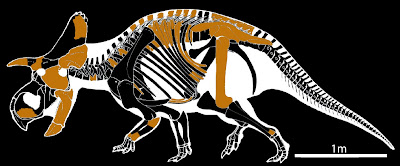 |
| Menefeeceratops sealeyi Dalman, Lucas, Jasinski, Lichtig & Dodson, 2021 Artwork by S. Krasovskiy. |
Abstract
An associated incomplete skeleton of a ceratopsid dinosaur from the Campanian deposits of the Allison Member of the Menefee Formation in New Mexico, USA is described. Although it was originally described over two decades ago, newly prepared portions of the Menefee Formation skeleton and reinterpretations of previously known morphology, in addition to newly described specimens have provided new information on ceratopsids, and centrosaurines in particular. These new data allow for a thorough reassessment of the specimen and the erection of a new taxon: Menefeeceratops sealeyi gen. et sp. nov., potentially the oldest recognized member of Centrosaurinae. Menefeeceratops sealeyi is represented by diagnostic cranial and postcranial skeletal elements. The cranial elements include a portion of the left premaxilla, a nearly complete left postorbital horncore, a parietal fragment, the right and left squamosals, the left jugal, the predentary, and the left dentary. Postcranial material consists of two cervical vertebrae, eight dorsal vertebrae, a partial sacrum with six sacral vertebrae, 11 dorsal ribs, the distal left radius, proximal and distal portions of the left ulna, the left femur, and a left metatarsal II. The taxonomic validity of Menefeeceratops sealeyi is supported by a combination of several morphological characters. These include a lack of epiossifications on the lateroposterior edge of the parietal (shared with Machairoceratops), three epiossifications on the squamosal, and three smaller, secondary undulations as part of episquamosal locus S1. There are also two subequal embayments on the posterior free margin of the squamosal with the more dorsal embayment (between episquamosal loci 1 and 2) distinctly larger than the ventral (= lateroventral) one (between episquamosal loci 2 and 3), three ridges on the lateral (dorsolateral) surface of the squamosal, an elongate posterior portion of the squamosal, the presence of a shallow but distinct groove on the medial surface of the squamosal nearly paralleling the ventrolateral and ventroposterior edges, elongate postorbital (= supraorbital) horns that are anteriorly curved distally, and two elongate ridges on the lateral surface of the dentary that diverge anteriorly, creating a distinct anterior triangular fossa. Phylogenetic analysis of Menefeeceratops sealeyi places this new species as a basal centrosaurine, most closely related to Crittendenceratops krzyzanowskii, thus adding to the growing record of centrosaurines discovered in western North America. It thus provides new information about the diversity of morphologies throughout different species and the temporal and paleobiogeographic distribution of these animals throughout Laramidia during the Late Cretaceous. Its presence as one of the, if not the, oldest members of the Centrosaurinae also suggests centrosaurines originated in the southern portions of western North America and the southern Rocky Mountain region, and subsequently radiated north during the upper middle to late Campanian.
Keywords: Dinosauria, Ceratopsidae, Centrosaurinae, Late Cretaceous, New Mexico, North America, Taxonomy, Evolution
Systematic paleontology
Ornithischia Seeley, 1887
Ceratopsia Marsh, 1890
Neoceratopsia Sereno, 1986
Ceratopsidae Marsh, 1888
Centrosaurinae Lambe, 1915
Menefeeceratops gen. nov.
Type species. Menefeeceratops sealeyi gen. et sp. nov.
Menefeeceratops sealeyi gen. et sp. nov.
Material. Holotype. NMMNH P-25052, a fragmentary skeleton consisting of the following elements: a left partial premaxilla, the nearly complete left postorbital horncore, a partial right squamosal, the left squamosal, an incomplete left parietal, the left jugal, the predentary, the left dentary, one cervical vertebra, eight dorsal vertebrae, a partial sacrum consisting of six sacral vertebrae, 11 dorsal ribs, the left ilium, the distal left radius, the proximal and distal portions of left ulna, the left metatarsal II, the left femur, and the distal end left fibula.
The holotype of Menefeeceratops sealeyi was collected under a permit issued by the U.S. Bureau of Land Management to the New Mexico Museum of Natural History and Science, Albuquerque, New Mexico.
Etymology. The generic epithet includes “Menefee” in reference to the Menefee Formation in which the type specimen was found. The Greek suffix “ceratops” (= horn-face) denotes membership in Ceratopsidae, which includes the new species. The specific epithet honors Paul Sealey, who discovered the type specimen.
 |
| Life reconstruction of Menefeeceratops sealeyi gen. et sp. nov. (artwork by S. Krasovskiy) |
Conclusions:
Menefeeceratops sealeyi is a new genus and species that represents the oldest current record of centrosaurine ceratopsid in North America (Fig. 24). It is basal to Centrosaurini and Pachyrhinosaurini and potentially is a member of the “Nasutoceratopsini”. Recognition of Menefeeceratops sealeyi adds to the growing species diversity of the Centrosaurinae in North America, and its presence in southern Laramidia fills in part of the evolutionary gap between the earlier Zuniceratops christopheri (~ 90 Ma) and the more derived ceratopsids known from the late Campanian in North America. The phylogenetic analysis suggests that derived members of the Centrosaurinae evolved rather quickly and lived at the same time as basal members. The presence of the oldest members of the Centrosaurinae in southern Laramidia suggests the clade evolved in the south and radiated north through the late Campanian. This is further corroborated by the presence of Campanian strata (~ 80 Ma) to the north (Alberta and Montana) that currently lacks evidence of centrosaurines. More material is needed, particularly of the parietal, to determine a more confident phylogenetic position of M. sealeyi and other potential “nasutoceratopsins” at, or near, the base of the Centrosaurinae.
Sebastian G. Dalman, Spencer G. Lucas, Steven E. Jasinski, Asher J. Lichtig and Peter Dodson. 2021. The Oldest Centrosaurine: A New Ceratopsid Dinosaur (Dinosauria: Ceratopsidae) from the Allison Member of the Menefee Formation (Upper Cretaceous, early Campanian), northwestern New Mexico, USA. PalZ. DOI: 10.1007/s12542-021-00555-w


